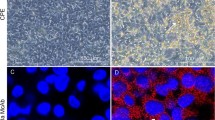Abstract
The main aim of our study was to explore the genome sequence of the inclusion body hepatitis associated Fowl adenovirus serotype 8b (FAdV-8b) UPM04217 and to study its genomic organisation. The nucleotide sequence of the whole genome of FAdV-8b UPM04217 was determined by using the 454 Pyrosequencing platform and the Sanger sequencing method. The complete genome was found to be 44,059 bp long with 57.9% G + C content and shared 97.5% genome identity with the reference FAdV-E genome (HG isolate). Interestingly, the genome analysis using ORF Finder, Glimmer3 and FGENESV predicted a total of 39 open reading frames (ORFs) compared to the FAdV-E HG that possessed 46 ORFs. Fourteen ORFs located within the central genomic region and 16 ORFs located within the left and right ends of the genome were assigned as being the high protein-coding regions. The fusion of the small ORFs at the right end terminal specifically in ORF22 and ORF33 could be the result of gene truncation in the FAdV-E HG. The frame shift mutation in ORF25 and other mutations in ORF13 and ORF17 might have lead to the emergence of genes that could have different functions. Besides, one of the minor capsid components, pVI, in FAdV-8b UPM04217 shared the highest similarity of 93% with that of FAdV-D, while only 47% similarity was found with FAdV-E. From the gene arrangement layout of the FAdV genome, FAdV-8b UPM04217 showed intermediate evolution between the FAdV-E HG and the FAdV-D although it was apparently more similar to the FAdV-E HG.


Similar content being viewed by others
References
Yan Z, Zak R, Zhang Y, Engelhardt JF. Inverted terminal repeat sequences are important for intermolecular recombination and circularization of adeno-associated virus genomes. J Virol. 2005;79:364–79.
Chiocca S, Kurzbauer R, Schaffner G, Baker A, Mautner V, Cotten M. The complete DNA sequence and genomic organization of the avian adenovirus CELO. J Virol. 1996;70:2939–49.
Ojkic D, Nagy É. The long repeat region is dispensable for fowl adenovirus replication in vitro. Virology. 2001;283:197–206.
Grgić H, Yang D-H, Nagy É. Pathogenicity and complete genome sequence of a fowl adenovirus serotype 8 isolate. Virus Res. 2011;156:91–7.
Marek A, Nolte V, Schachner A, Berger E, Schlötterer C, Hess M. Two fiber genes of nearly equal lengths are a common and distinctive feature of Fowl adenovirus C members. Vet Microbiol. 2012;156:411–7.
Marek A, Kosiol C, Harrach B, Kaján GL, Schlötterer C, Hess M. The first whole genome sequence of a Fowl adenovirus B strain enables interspecies comparisons within the genus Aviadenovirus. Vet Microbiol. 2013;166:250–6.
Corredor JC, Krell PJ, Nagy É. Sequence analysis of the left end of fowl adenovirus genomes. Virus Genes. 2006;33:95–106.
Sheppard M, McCoy RJ, Werner W. Genomic mapping and sequence analysis of the fowl adenovirus serotype 10 hexon gene. J Gen Virol. 1995;76:2595–600.
Davison AJ, Benko M, Harrach B. Genetic content and evolution of adenoviruses. J Gen Virol. 2003;84:2895–908.
Corredor JC, Garceac A, Krell PJ, Nagy É. Sequence comparison of the right end of fowl adenovirus genomes. Virus Genes. 2008;36:331–44.
Griffin BD, Nagy E. Coding potential and transcript analysis of fowl adenovirus 4: insight into upstream ORFs as common sequence features in adenoviral transcripts. J Gen Virol. 2011;92:1260–72.
Washietl S, Eisenhaber F. Reannotation of the CELO genome characterizes a set of previously unassigned open reading frames and points to novel modes of host interaction in avian adenoviruses. BMC Bioinform. 2003;4:55.
Calvo SE, Pagliarini DJ, Mootha VK. Upstream open reading frames cause widespread reduction of protein expression and are polymorphic among humans. Proc Natl Acad Sci. 2009;106:7507–12.
Barbas CF, Burton DR, Scott JK, Silverman GJ. Quantitation of DNA and RNA. CSH Protoc. 2007;2001:pdb.ip47.
Benson G. Tandem repeats finder: a program to analyze DNA sequences. Nucleic Acids Res. 1999;27:573–80.
Darling ACE, Mau B, Blattner FR, Perna NT. Mauve: multiple alignment of conserved genomic sequence with rearrangements. Genome Res. 2004;14:1394–403.
Brudno M, Do CB, Cooper GM, Kim MF, Davydov E, NISC Comparative Sequencing Program, et al. LAGAN and multi-LAGAN: efficient tools for large-scale multiple alignment of genomic DNA. Genome Res. 2003;13:721–31.
Honkavuori KS, Pollard BD, Rodriguez MS, Hay RT, Kemp GD. Dual role of the adenovirus pVI C terminus as a nuclear localization signal and activator of the viral protease. J Gen Virol. 2004;85:3367–76.
Acknowledgements
This work was supported by the Science fund research grant 02-01-04-SF1046 from the Ministry of Science, Technology and Innovation of Malaysia (MOSTI) and the Research University Grant Scheme, vote number 91635, Universiti Putra Malaysia, Malaysia. The authors would also like to thank Professor Soon Guan Tan, formerly Associate Editor of Elsevier Editorial System, Gene, for proof reading the manuscript.
Author information
Authors and Affiliations
Corresponding author
Additional information
Publisher's Note
Springer Nature remains neutral with regard to jurisdictional claims in published maps and institutional affiliations.
Electronic supplementary material
Below is the link to the electronic supplementary material.
Online Resource 2
Schematic representation of the FAdV-8 UPM04217 genome map. The directions of transcription for the predicted ORFs are indicated by the arrows. Blue: genus-common genes, yellow: genus-specific genes, green: different from their homologous gene in FAdV-8 HG isolate (TIFF 1824 kb)
Online Resource 4
Genome organisation comparisons of Malaysian fowl adenovirus (UPM04217) with other FAdVs species (TIFF 2466 kb)
Online Resource 6
The dot plot alignment of fowl adenovirus species E with UPM04217 FAdV Malaysian isolate. The red diagonal line shows the agreement between the two sequences (TIFF 2049 kb)
Rights and permissions
About this article
Cite this article
Mat Isa, N., Mohd Ayob, J., Ravi, S. et al. Complete genome sequence of fowl adenovirus-8b UPM04217 isolate associated with the inclusion body hepatitis disease in commercial broiler chickens in Malaysia reveals intermediate evolution. VirusDis. 30, 426–432 (2019). https://doi.org/10.1007/s13337-019-00530-9
Received:
Accepted:
Published:
Issue Date:
DOI: https://doi.org/10.1007/s13337-019-00530-9




